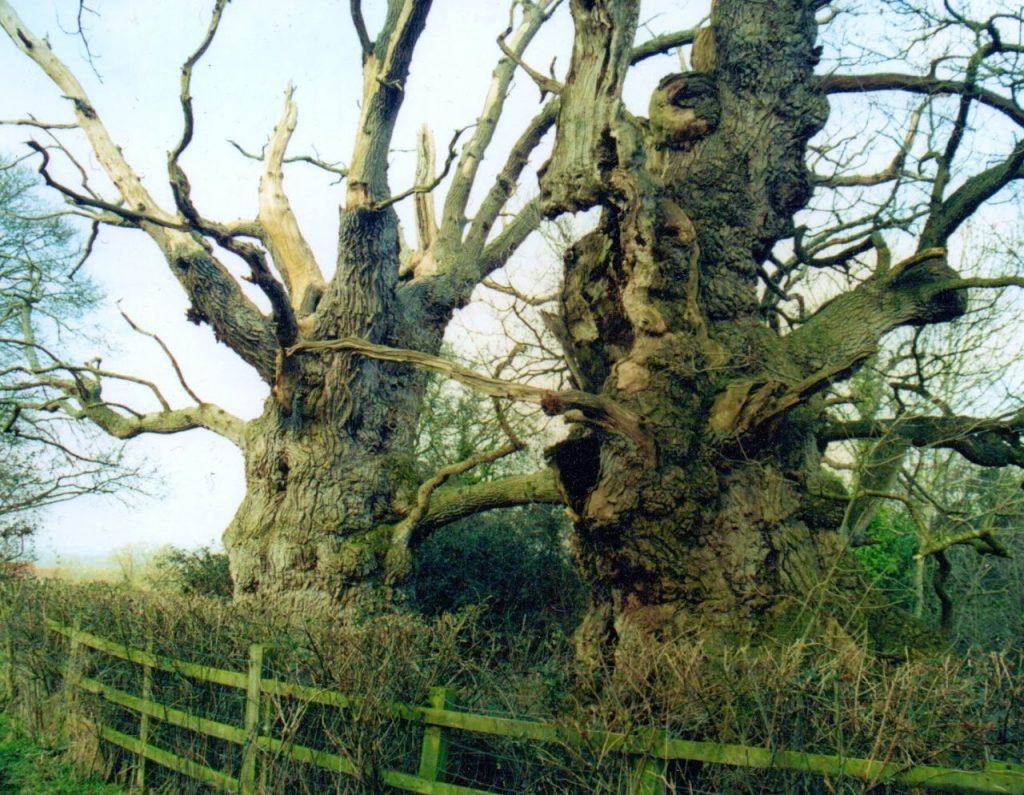Tucked away in a quiet field near Glastonbury Tor once stood two of Britain’s most storied oak trees—Gog and Magog, estimated to be over 2,000 years old. These ancient oaks were believed to mark the remnants of a ceremonial Druidic avenue leading to the sacred Tor, their gnarled limbs bearing silent witness to centuries of myth, ritual, and change. Sadly, only Magog remains today. Gog was severely damaged by fire in 2017 and did not survive, making Magog the last living sentinel of what was once a sacred grove in the heart of Albion.
The names Gog and Magog might ring a bell if you’ve dabbled in biblical stories or British folklore. Biblically, they’re apocalyptic giants mentioned in the Book of Revelation. In British myths, they’re often portrayed as ancient giants and guardians, the last of their kind roaming Albion—an old name for Britain. So, these trees aren’t just old; they carry layers of meaning that bridge history, legend, and spirituality.
Oaks have long held a special place in mythology around the world. For the Druids—those mysterious Celtic priests—the oak was sacred beyond words. It was a tree that connected the earthly world to the spirit realm, a natural gateway where magic and nature intertwined. Interestingly, the word “Druid” itself is believed to come from the Celtic word for oak, “dru”, which shows just how important these trees were in their spiritual practices.
This reverence for oaks isn’t unique to Celtic culture. In Norse mythology, for example, the mighty god Thor—the god of thunder—was associated with the oak. This makes a lot of sense since oaks often attract lightning strikes because of their height and moisture, making them natural symbols of power and protection. Similarly, the ancient Greeks and Romans linked the oak to Zeus and Jupiter, their respective gods of the sky and thunder, reinforcing the oak’s role as a divine symbol.
Beyond gods and thunderbolts, the oak’s symbolism is deeply tied to qualities like strength, endurance, and wisdom. It’s easy to see why—oak trees live for centuries, standing tall and resilient through storms, droughts, and the passing of time. In many cultures, oaks were seen as guardians of the community, often serving as gathering places for important rituals and ceremonies. They were more than just trees; they were living monuments to nature’s power and humanity’s connection to it.
Gog and Magog, as ancient oaks, perfectly embody these qualities. Their survival for two millennia through the changing tides of history is nothing short of miraculous. They connect us to a time when nature and myth were intertwined in everyday life, reminding us of stories passed down through generations, stories that still captivate the imagination.
In 2017, the story of these trees took a sad turn when Gog suffered a devastating fire. The damage was so severe that Gog could not recover, a powerful reminder that even the mightiest living beings are vulnerable. But Magog still stands, a symbol of resilience and a living bridge between past and present, continuing to inspire visitors who come seeking a connection to Glastonbury’s rich spiritual heritage.
Visiting Magog isn’t just about seeing an old tree—it’s about tapping into layers of myth, history, and nature all rolled into one. It stands as a guardian of tradition, a testament to endurance, and an invitation to reflect on the deep relationship humans have always had with the natural world.
In a world that often races forward, chasing the new and shiny, the story of Gog and Magog reminds us to slow down, appreciate the old, and listen to the whispers of the past. After all, sometimes the oldest trees tell the richest stories—stories about giants, gods, and the sacred power of the humble oak.
